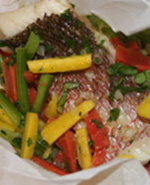An
heirloom tomato is an open-pollinated (non-hybrid) cultivar of tomato.
Heirloom tomatoes have become increasingly popular and more readily available
in recent years.
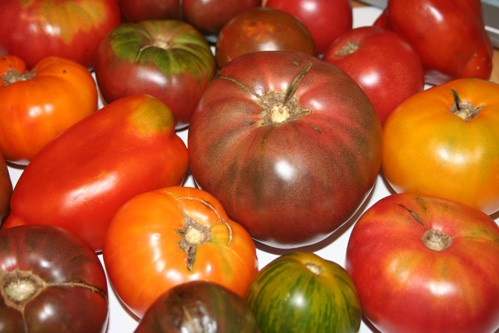
Requirements
The
definition of the use of the word heirloom to describe plants is highly debated.
One school of thought places an age or date point on the cultivars. For instance,
one school says that the seeds must be over 100 years old, others 50 years, and
others pick an arbitrary date of 1945 which marks the end of World War II and
roughly the beginning of widespread hybrid ue by growers and seed companies or
industrial agriculture. It was after the end of World War II that hybrid seeds
began to proliferate in the commercial seed trade.
Another way of defining
heirloom cultivars is to use the definition of the word "heirloom" in its truest
sense. Under this interpretation, a true heirloom is a cultivar that has been
nurtured, selected, and handed down from one family member to another for many
generations.
Additionally, there is another category of cultivars that could
be classified as "commercial heirlooms," cultivars that were introduced many generations
ago and were of such merit that they have been saved, maintained and handed down
- even if the seed company has gone out of business or otherwise dropped the line.
Additionally, many old commercial releases have actually been family heirlooms
that a seed company obtained and introduced.
Regardless of a person's specific
interpretation, most authorities agree that heirlooms, by definition, must be
open-pollinated. They may also be open pollinated varieties that were bred and
stabilized using classic breeding practices. It is currently generally agreed
that no genetically modified organisms can be considered heirloom cultivars. Another
important point of discussion is that without the ongoing growing and storage
of heirloom plants, the seed companies and the government will control all seed
distribution. Most, if not all, hybrid plants cannot be regrown from the seeds
of the original plant, thus insuring the dependency on seed distributors for future
crops.
Heirloom tomato cultivars can
be found in a wide variety of colors, shapes, flavors and sizes. Some cultivars
can be prone to cracking or lack disease resistance. As with most garden plants,
cultivars can be acclimated over several gardening seasons to thrive in a geographical
location through careful selection and seed saving.
| Beefsteak
Tomato | 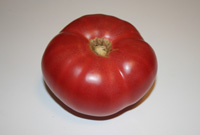 | Beefsteak
tomatoes are the largest varieties of cultivated tomatoes, sometimes weighing
1 lb (.5 kg) or more. Most are pink or red with numerous small seed compartments
distributed throughout the fruit, sometimes displaying pronounced ribbing similar
to ancient pre-columbian tomato cultivars. |
| Eva Purple
Ball | 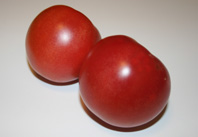 | A
heirloom variety from the Black Forest Region of Germany. Excellent mid-sized
tomato with thin skin and purplish tinge. Blemish free with great flavor |
| Cherokee
Purple | 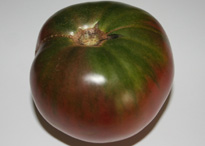 | Purple
Cherokee tomatoes are beefsteak in style, with green "shoulders" across the top.
It was one of the first of the "black" color group of tomatoes. This variety is
over 100 years old and was originally grown by the Cherokee Indians The tomato
has an excellent rich flavor and is considered one of the best heirlooms. One
of the very first known "black", or deep dusky rose colored cultivars that are
becoming so popular. Named in 1990 by Craig LeHoullier, who received seeds of
an unnamed cultivar in the mail from J. D. Green of Tennessee. Mr. Green indicated
that the "purple" tomato cultivar was given by the Cherokee Indians to his neighbor
"100 years ago". |
| Green Zebra | 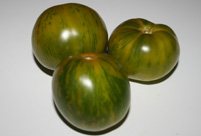 | Green
Zebra is a tomato cultivar with characteristic green and yellow stripes. It is
slightly more tart than regular tomatoes, and has dark green flesh when ripe.
|
| Black Krim | 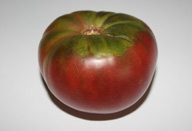 |
A dark red to brown cultivar often cited online as being from from the "island
of Krim" in the Black Sea, better known as the Crimean peninsula in Ukraine (Crimea
is known in Ukrainian as Krim). |
| Japanese | 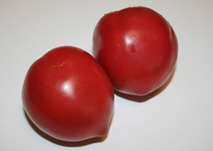 | Heart
shaped tomato with bright red interior. |
| Black Pear
| 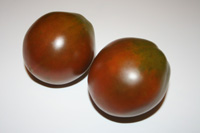 | Smokey
taste similar to Cherokee Purple |
| Mexican (Red Calabash) | 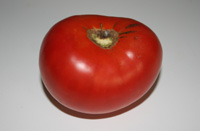 | Beefsteak
type tomato from Mexico. This is a delicious, thin-skinned heirloom from the state
of Chiapas in Mexico. |
| Canistrino | 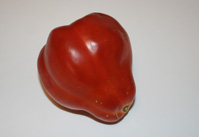 | Italian
Heirloom tomato. Excellent for sauces. |
| Brandy Wine
| 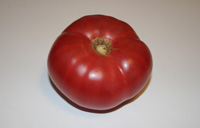 |
The tomato listed as simply "Brandywine" is one of the tomato varieties responsible
for the ascendance of the popularity of heirloom varieties due to its excellent
flavor and somewhat clouded history. A large fruited pink (red flesh, clear skin)
variety produced on vigorous potato leaf foliage plants, Brandywine was passed
on from the Sudduth family to a Ohio tomato enthusiast named Ben Quisenberry.
Many seed savers traded seeds with Ben, and Brandywine eventually became widely
available. Though a variety named "Brandywine" was offered in the late 1800s by
the Stokes and Johnson seed company, that appeared to be a red fruited variety
with regular leaf foliage. More likely is that Brandywine is a descendant of two
similar (if not identical) varieties offered in the 1880's - Mikado (Henderson
seed company) or Turner's Hybrid (Burpee Seed Company). This is the most well
known heirloom variety from the late 1800's which has an incredibly sweet flavor.
Huge sized fruit start out pink and turn slowly red and then slightly purple as
they ripen completely. |
| Hillibilly | 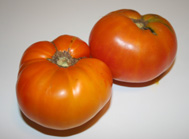 | Orange
colored with dark red streaking throughout. Fruits have sweet and fruity flavor
with high sugar content and high acidity. Heirloom variety from West Virginia
in the 1800's. |
| German Stripe | 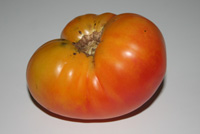 | This
is an old german heirloom variety producing huge boat shaped fruits weighing as
much as 2 pounds. Color is golden yellow with pink to red stripes that varies
from fruit to fruit. Excellent for slicing. |
| Polish
Linguisa | 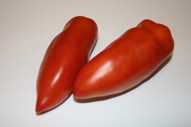 | Tomatoes
are very sweet and are more productive than most heirloom varieties. These huge
sausage shapd tomatoes are excellent for making paste and sauce. A heirloom variety
from New York, USA dating back to the 1800's. |
| Mortgage
Lifter | 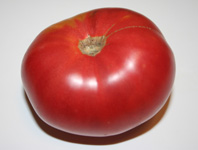 | Tomatoes
have a sweet rich flavor and turn deep pink when mature. This variety was developed
in the 1930's by Mr. Byles of Logan, WV to help pay off his home mortgage. He
crossed a German Johnson, Beefsteak, and Italian & English varieties to come up
with this unique variety. Sweet and Tasty, also makes a good roasted tomato. |
Other
heirlooms














